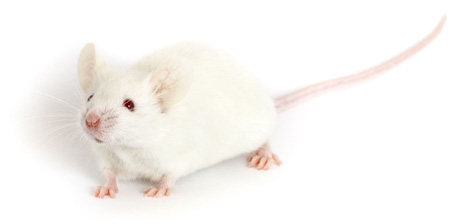AIDS patients have a new friend — JAX® Mice strain NOD.Cg-Prkdcscid Il2rgtm1Wjl/SzJ (005557) — commonly called NOD scid gamma (NSG), a promising new model that supports HIV-AIDS research. The mouse has been successfully used by a group of researchers, including JAX Professor Leonard D. Shultz, Ph.D., to demonstrate that small interfering RNAs (siRNAs) can suppress the spread of HIV in human cells (Kumar et al. 2008).
One of the greatest obstacles to HIV-AIDS research has been the lack of a suitable small-animal model. HIV infects only humans and chimpanzees. In the last decade, several immunodeficient mouse strains have been constructed (Shultz et al. 2007) to facilitate engraftment of a human immune system and subsequent infection with HIV. However, due to their residual immune functions, earlier generations of these strains supported low and variable levels of human cell engraftment.

Because the NSG mouse lacks mature T cells, B cells and functional NK cells, and is deficient in cytokine signaling, it enables better engraftment of human hematopoietic stem cells and human peripheral-blood mononuclear cells, compared to any other published mouse strain (Shultz et al. 2005).
With a reliable NSG mouse model of HIV in hand, Kumar et al. designed siRNAs to inhibit the expression of two key HIV genes and a gene in the human T cells encoding an HIV co-receptor. The siRNAs were specifically targeted to human T cells with an antibody that recognizes a surface protein on most human T cells. This novel siRNA treatment protected the transplanted human peripheral blood leukocytes from HIV challenges. It not only substantiated the use of the NSG mouse as an HIV-AIDS model but suggests a promising new method for treating HIV-AIDS.
References
Kumar P, Ban HS, Kim SS, Wu H, Pearson T, Dale L. Greiner, Laouar A, Yao J, Haridas V, Habiro K, Yang YG, Jeong JH, Lee KY, Kim YH, Kim SW, Peipp M, Fey GH, Manjunath N, Shultz LD, Lee SK, Shankar P. 2008. T cell-specific siRNA delivery suppresses HIV-1 infection in humanized mice. Cell 134:577-86.
Shultz LD, Ishikawa F, Greiner DL. 2007. Humanized mice in translational biomedical research. Nat Rev Immunol 7:118-30.
Shultz LD, Lyons BL, Burzenski LM, Gott B, Chen X, Chaleff S, Kotb M, Gillies SD, King M, Mangada J, Greiner DL, Handgretinger R. 2005. Human lymphoid and myeloid cell development in NOD/LtSz-scid IL2R gamma null mice engrafted with mobilized human hematopoietic stem cells. J Immunol 174:6477-89.